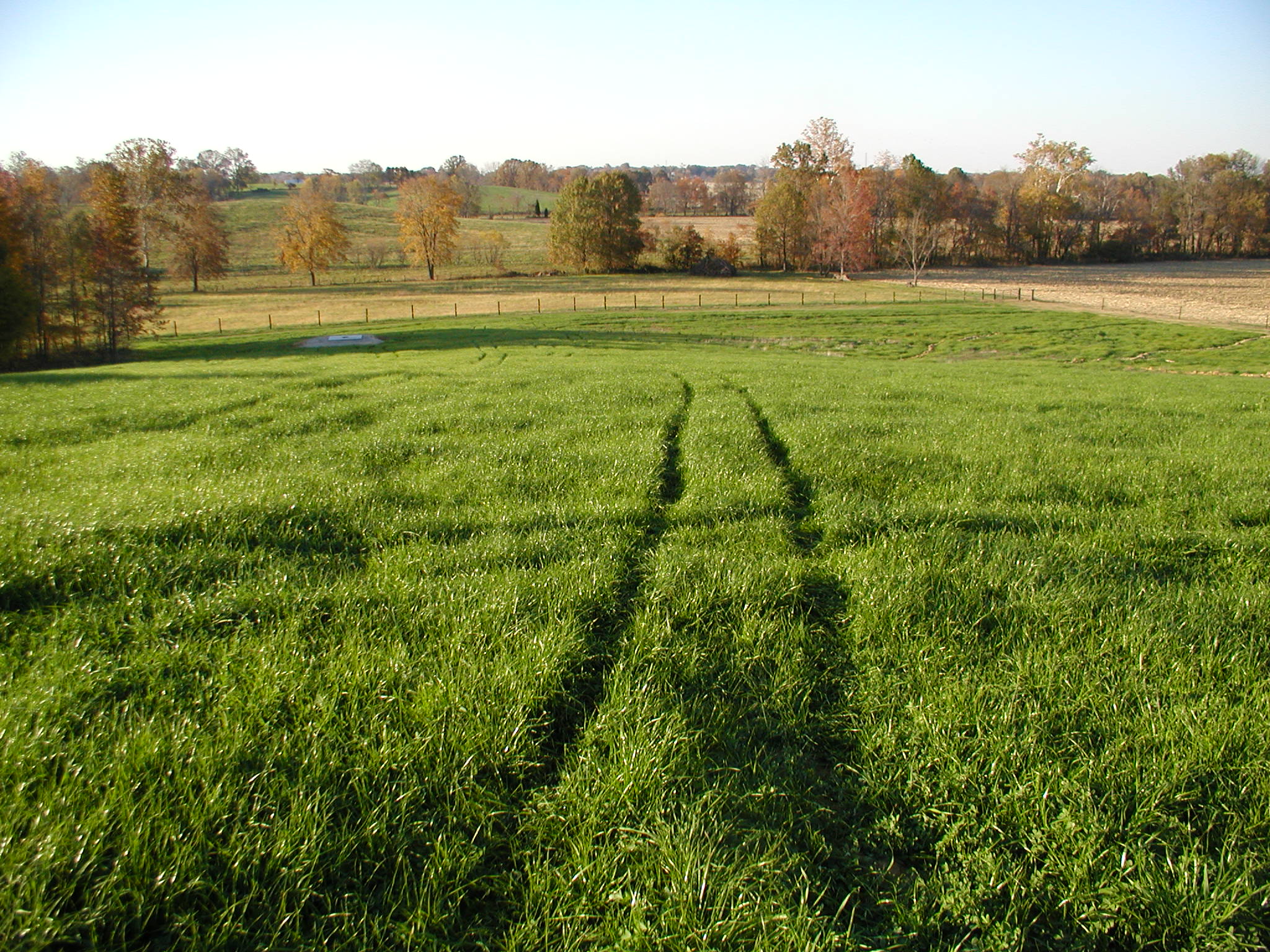
Drought plagued many parts of the country over the past couple years. Dust storms, sweltering heat, raging wildfires, failed crops, all effects of an ecosystem lacking adequate precipitation. No doubt those conditions left your perennial pastures, especially cool season perennial pastures, in critical condition. Where is the silver lining in that?
If nature has hit the reset button for you, then this is an opportunity to put your perennial pastures on a new and better trajectory. This is a chance to overseed clovers and alfalfa or replace your Kentucky 31 fescue with a new and improved variety with a friendly endophyte.
Once the rains come, the drought stricken soil won’t stay bare for long so decisions need to be made now! Proactivity is your greatest ally and we’re here to help.
Incorporating Annuals
One strategy is to plant an annual cover crop to help restore the biological life in your soil and then reseed to perennials this fall. For most areas, the two weeks on either side of Labor Day are the ideal time to do a new perennial seeding. This gives the new perennials a chance to establish and then go dormant and when the warmth of next spring comes, they take off from a root system, and not just from a seed. This extra advantage really helps them get ahead of the weeds that will want to take advantage of the changing ecosystem as well.
Another option is to do your perennial seeding this spring and take advantage of the winter moisture and spring growing conditions. If this is your choice, the time to act is now and get your seed in hand so that you are ready to plant as soon as conditions allow.
While a multitude of options are available, here are a few examples of mixes that could work for either of these seeding times
Cool Season Pasture, >25” annual precipitation
- 5-7# of legumes: Red Clover, White Clover, Alfalfa, Trefoil
- 9-15# of cool season grasses: Meadow brome, Orchardgrass, Estancia Fescue, Perennial Ryegrass
- 2-4# of Forbs: Chicory, Plantain, Small Burnett
- Mycorrhizal fungal inoculation
Cool Season Pasture, <25” annual precipitation
- 4-6# of legumes: Red Clover, White Clover, Alfalfa, Trefoil
- 8-12# of cool season grasses: Wheatgrass, Meadow and Smooth brome, Estancia Fescue
- 1-3# of Forbs: Chicory, Plantain, Small Burnett
- Mycorrhizal fungal inoculation
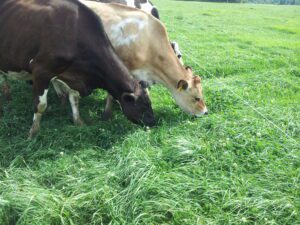
Cattle grazing a cool season pasture
Short Term Pasture, 2-3 years
- 6-8# of legumes: Red Clover, Alfalfa
- 8-12# of cool season grasses: Intermediate ryegrass, Festulolium, Meadow brome, Estancia Fescue, Orchard Grass
- 1-2# of Forbs: Chicory, Plantain
- Mycorrhizal fungal inoculation
Establishing Perennials – Patience is a Virtue
Establishing perennials is not a quick fix. These small seeds require a time and money investment. For those willing to wait it out, however, the payoff will be great. Perennial pastures, especially diverse perennial pastures, can produce high quality forage with little to no inputs for years to come.
When establishing cool season perennials, we recommend planting early spring or late summer. Then allow the perennials to establish for two growing seasons. Cool season species generally exhibit two growing seasons during a year; once in the spring and then again in the fall. So if you planted your perennials in the spring, they should be allowed to grow without disturbance through the spring and fall. Depending on the health of the plants by late fall, grazing during the winter could be a viable option. Otherwise wait until the following spring to begin grazing.
A Bio Boost
Drought affects every creature in an ecosystem, and arguably the smallest are the most vulnerable. As a result many of these microbial colonies are likely struggling and could use a little boost. MycoGreen NPK might just be your ticket. With a plethora of different nitrogen fixing, phosphorus and potassium solubilizing bacteria along with a full lineup of mycorrhizal fungi, this seed applied inoculant can really add huge value and longevity to your perennial plantings.

Additionally, we’ve picked our favorite species to help you navigate the perennial puzzle.
Estancia fescue is a novel endophyte fescue, meaning that it is not toxic and will not cause harm to cattle or livestock who consume it. Estancia is highly productive, producing an average of 4 tons of dry matter of highly palatable, nutritious forage every year. With superb seedling vigor, Estancia is an excellent option for overseeding existing pastures. Use Estancia in areas where a toxic endophyte is a problem.
Teton 2 Endophyte Free Tall Fescue is an endophyte free tall fescue with excellent seedling vigor. This variety is very quick to germinate and establish, making it a successful interseeding crop. Teton 2 is best used in pastures with Kentucky 31 as the dominant grass.
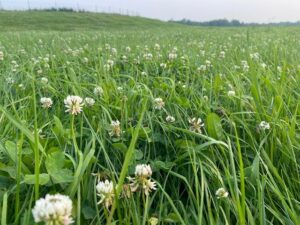
Grass and clover mix
Devour Orchardgrass is commonly thought to be a high rainfall environment grass. Indeed most varieties require ample amounts of precipitation to thrive or even exist. Devour offers a new opportunity for the western plains regions to add this cool season grass to their perennial pastures. With excellent summer and fall regrowth capacity compared to other cool season grasses, orchard grass is an excellent way to diversify a perennial pasture. This improved variety is also more tolerant to diseases like rust.
Birdsfoot trefoil is of particular value as a pasture legume, because it contains condensed tannins to prevent bloat. It is tolerant of acidic and wet soil, giving it an advantage over many other pasture legumes in these environments. It is roughly half as productive as alfalfa on soils which both are adapted but can exceed alfalfa production on poorly drained or acidic soil. It works best when planted as part of a new pasture seeding rather than interseeding into an existing pasture.
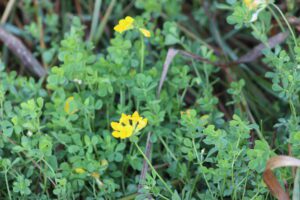
Birdsfoot trefoil
Stamina White Clover is an improved variety of Intermediate Ladino white clover, developed for improved heat and drought tolerance. Additionally, white clover tolerates saturated soils and heavy grazing pressure. Ladino is known for its large leaf size and overall productivity. This clover is an excellent addition to just about any pasture mix.
Red Clover may be the most common clover available, producing high amounts of biomass in a season. Historically, this productivity only lasts 2-3 years, however newer varieties tend to live longer than the older varieties. Additionally, red clover displays no autotoxicity, so it can be reseeded into a pasture with existing red clover. This species is an excellent option for frost seeding.
Chicory is a very productive, palatable, and deep taprooted forb that resembles the structure of a large dandelion with multiple flowers. The foliage is high in protein, phosphorus, copper, and zinc, making this a particularly palatable and nutritious plant. The polyphenols in this plant are similar to tannin that help eliminate intestinal parasites and reduce bloat.
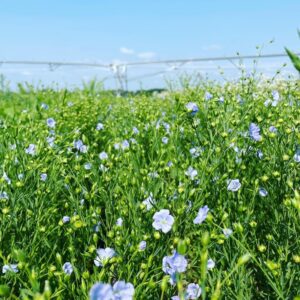
Chicory flowers
Plantain is a low-growing forb that, like chicory, is high in minerals It also contains a natural antibiotic a compound that helps reduce infections and modifies rumen fermentation to improve animal performance, not unlike an ionophore such as Rumensin. Plantain grows very well on compacted soils, helping to loosen the tight soil.
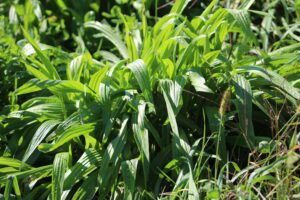
Plantain
We are happy to put together one of these mixes for you or help you explore any other perennial options that you may need for your operation. Give us a call at 402-469-6784.
Want to talk with one of our expert sales representatives?
Fill out this form or give us a call today. 402-469-6784.
